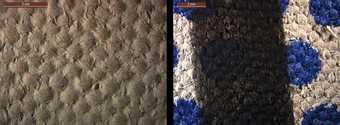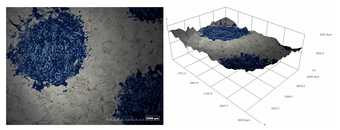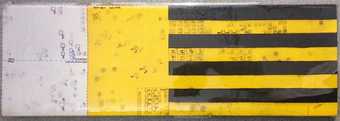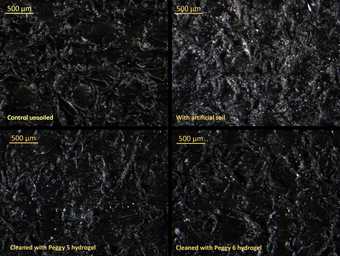A lot has happened since we introduced the second NANORESTART case study ten months ago. The team have been hard at work characterising the painting and evaluating different surface cleaning options to prepare a tailored conservation strategy for Whaam!.
While waiting for the mock-ups to age, we examined the painting surface in detail, explored Lichtenstein’s artistic practice and gained more knowledge of his desired surface aesthetic.
Tate Photography took images of the two panels in normal and UV lights, while the painting surface was explored using optical and digital microscopy as well as gloss and colour measurement. Closer examination of the painting showed the order of application of the paint layers, confirming that they were all thinly applied, revealing the underlying paint/priming layers and the canvas weave structure (figs.1 and 2).

Fig.1
(Left) Photomicrograph of the white alkyd priming: the layer is thinly applied, in some areas worn or abraded, revealing the texture of the canvas underneath.
(Right) Photomicrograph showing black Magna paint overlapping blue Ben-Day dots, which are still visible through the thin black paint.

Fig.2
A 2D Hirox digital image showing an area with blue Ben-Day dots (on the left) and 3D reconstruction (on the right). The 3D image provides information on the topography of the paint surface and, in this case, an idea of the thickness of the ultramarine blue oil paint used for the Ben-Day dots.
Due to the lean nature and different solvent-responses of the paint types used in Whaam! (alkyd, oil and Magna), we had to explore a range of surface cleaning materials and methods to devise an appropriate system for the treatment of this work.
We started this process using our mock-up samples, which – even after ageing – proved to be less sensitive to mechanical action than the painting surface, but were nonetheless suitable for a screening process with selected free liquids (such as water and organic solvents) using a standard cotton swab application procedure. The options that were evaluated included commonly used materials such as deionised, adjusted and buffered waters, organic solvents (alcohols, hydrocarbons and silicones), and water-based systems with added chelating agents and surfactants. Where any non-volatile materials were added, a clearance step was also performed.
These evaluations were carried out on artificially soiled and unsoiled areas of two of our mock-ups, one with passages of white alkyd resin (like the priming on the painting) and yellow and black Golden Artist Color MSA paint (the current version of Magna paint – as per the yellow parts of the painting as in fig.3) and another that approximated the blue Ben-Day dot area, comprised of the alkyd priming layer and oil-based ultramarine blue paint.1

Fig.3
This mock-up consists of white alkyd resin, yellow and black Golden MSA paints; the surface of the mock-up was artificially soiled, with unsoiled and soiled areas left as controls. Cleaning tests were marked on the Mylar template for future reference.
After a lengthy testing period, we identified cleaning solutions which were effective at reducing the soiling from the mock-up surfaces. This was followed by combining these cleaning solutions with appropriate gel systems, in order to minimise any mechanical effects during the cleaning process.
Among the gels commonly used by conservators, we primarily selected rigid gels; which required minimum mechanical action for their application or removal, and those with highly solvent-retentive properties (those which release minimal liquid) to avoid affecting any water-sensitive areas, such as the oil-based Ben-Day dots.
The range of gels evaluated included natural polysaccharide-based rigid gels (Agarose and Gellan gum), silicone emulsifiers (Velvesil Plus, Shin-Etsu KSG 210 and Shin-Etsu KSG 350z) and a rigid chemical hydrogel made of poly (2-hydroxyethyl methacrylate) and polyvinylpyrrolidone (known as Nanorestore Gel® Extra Dry).2 We were also able to evaluate some polyvinyl alcohol-based gels provided to us by the NANORESTART project leaders, CSGI, in Florence.3 These gels are currently known as Peggy 5 (a blend of polyvinyl alcohol and polyvinylpyrrolidone monomers) and Peggy 6 (a polyvinyl alcohol-based gel).
We firstly evaluated these gels loaded with deionised water in order to compare their physical properties, ease of use and suitability. This allowed us to become more acquainted with the various preparation procedures, application processes and handling properties of the gels (fig.4). Although the detailed results of this study will be published soon, both Peggy gels proved to be more flexible than the other rigid gels tested, and conformed extremely well to the paint and canvas surfaces, making good contact and providing a promising level of cleaning (soil removal).

Fig.4
All gels applied onto the soiled black MSA mock-up
We then proceeded to apply the selected gels (loaded with water) to the mock-up surfaces and assessed their performances across a range of empirical criteria such as: soil removal efficacy, surface wetting, pigment removal, surface gloss change, visible cleaning system residues, ease of application and any Health and Safety implications. For each parameter, we rated the gel system on a scale from 1 (lowest/worst) to 5 (highest/best), and the results were plotted as star diagrams (fig.5). In general, we can see that the Peggy 5 (red star) and Peggy 6 (green star) gels both performed well compared to the others also tested.
As part of our evaluation methodology, we imaged the cleaned areas using a microscope, which helped us to explore the effects of the cleaning systems on the underlying paint films and determine the amounts of soiling removed. From this we could see that the Peggy gels loaded with water did not completely remove the applied soil from the mock-up surface (fig.6).

Fig.5
Star diagram showing the performance of several gels loaded with deionised water. The Peggy 6 gel (green line) proved to be the most highly-rated system, the Peggy 5 gel also rated well.

Fig.6
Photomicrographs showing the surface of the black mock-up: TL – a control area (i.e. with no artificial soil applied), TR – an area with artificial soil applied and BL and BR – areas cleaned with Peggy hydrogels (loaded with water). We can see that the areas treated with Peggy gels have some soil particles remaining (which appear lighter in colour in these images).
In order to increase the soiling removal efficacy of the Peggy 5 and Peggy 6 gels, we then loaded them with the most promising free-solvent combinations from our preliminary tests, which included aqueous micellar solutions of non-ionic surfactants (BS2 and ECOSURF™ EH6) and the chelator tri-ammonium citrate.
We then evaluated these tailored gels on our range of mock-ups, varying the concentration of the surfactants/chelators and other aspects such as aqueous pH to explore the effects on the soiling removal and underlying paint films. For comparison, we also included Nanorestore Extra Dry gels and Velvesil Plus emulsifier loaded with the same aqueous systems. In all cases – due to the presence of surfactants and chelators – a clearance step was performed. For the Velvesil Plus gel a cyclic silicone solvent was used, whilst for the other gels clearance was carried out using the same gel loaded with deionised water only and applied for the same period of time.
The assessment of these tailored options once again revealed that the Peggy 6 gel proved to be the most effective system in terms of soil removal. The analysis of the mock-ups surfaces confirmed that very few particles of the artificial soil remained after cleaning and that the underlying paint surfaces remained intact. When compared to other options, the Peggy 6 gel offers advantages such as transparency and flexibility, which enable better control over the cleaning procedure, and enhanced conformation to the canvas texture which made the Peggy 6 gel the optimal candidate for cleaning Whaam!.
Tune into our next update for the final tests and painting treatment!
Angelica Bartoletti, Rachel Barker and Bronwyn Ormsby
March 2018
